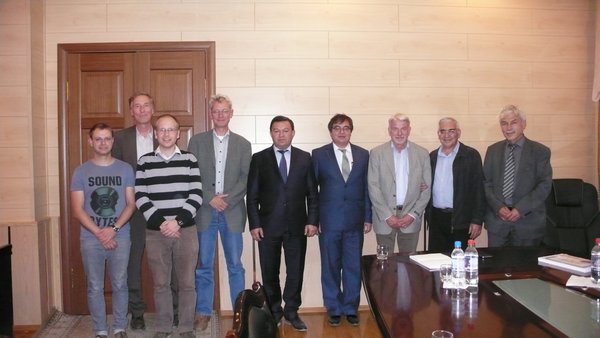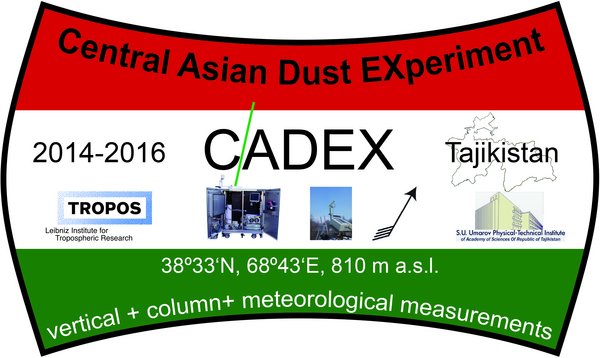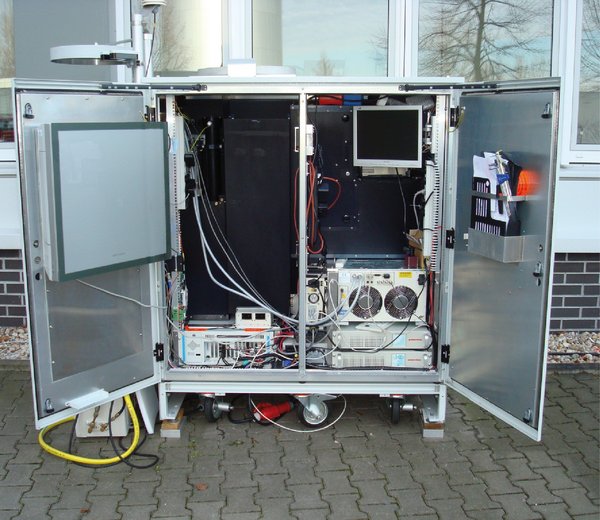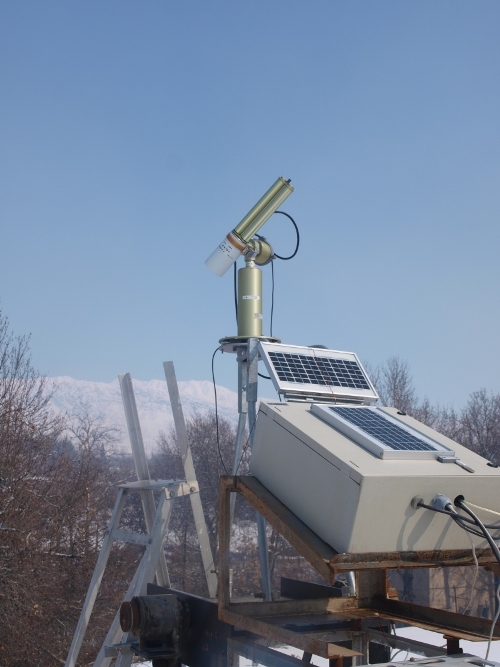CADEX investigates dust over Central Asia
Leipzig, 24.10.2014
Tajik Academy of Sciences and TROPOS cooperate on aerosol research
Dushanbe. The dust over Central Asia plays a crucial role in Central Asia’s climate change. To understand this, knowledge about the dust’s properties and transport needs to be gained. On that account, the Academy of Sciences of Tajikistan and the Leibniz Institute for Tropospheric Research (TROPOS) will conduct a joint measurement campaign until fall 2016. A cooperation agreement was signed by both partners whereby the basis for the joint Tajik-German project CADEX (Central Asian Dust Experiment) was set up. The planned investigations will be the first vertical resolved measurements since 1989 in Tajikistan and the first measurements with a Lidar in Tajikistan at all. It is still little known about the amount and composition of dust over Central Asia, due to the lack of available measurement technology in this region.
Climate change is already clearly noticeable in Central Asia: For instance, the glaciers of Tajikistan have shrunk in recent decades by a third. Dust deposits on glacier surfaces play a role in that shrinking, particularly as they change the glacier surfaces and their radiation properties and thereby contribute to the melting of the ice. Tajikistan is surrounded by arid areas and deserts. The Taklamakan desert or the partially desiccated Aral Sea are just two of the famous ones. Consequently, dust events occur frequently and reach regions far beyond. Nevertheless, there has been no systematic long-term observations of these dust particles so far. Particularly the vertical distribution and the optical properties of the aerosol particles are mostly unknown. However, such data is important in order to calculate the earth’s radiation budget and hence the heating of the atmosphere accurately.
"These knowledge gaps we want to fill with the CADEX project in the next two years," said Dr. Dietrich Althausen from TROPOS. "The colleagues from the Academy of Sciences of Tajikistan measure the solar radiation on the ground and contribute weather data. We from TROPOS will bring one of our portable lidars to Dushanbe and use it to examine the vertical profiles of dust particles from the ground." These measurements are important not only for the assessment of air quality, they are also a new scientific questions. The last dust measurements in the atmosphere over Tajikistan are from fall 1989 and took place more than a quarter of a century ago. At that time, a Soviet-American team carried out aircraft measurements on two days in September. So continuous measurements with a lidar, which will be conducted in Dushanbe at about 800 m a.s.l. for about a year, will be the first of their kind in Tajikistan. The capital of Tajikistan, whose territory lies to more than one half above an altitude of 3000 meters, has around 700,000 inhabitants and is the political, cultural and economic center of the country. The measurements in Dushanbe will fill a large blank area ranging far over thousand kilometers on the global aerosol-map.
The measurements will be performed by the Polly-XT system, a multi-wavelength depolarization Raman lidar which was developed at TROPOS. The device emits laser pulses. The distance to the object is identified – similar to radar - from the time delay of the reflected or scattered light pulses. The scientists determine physical properties of the reflecting objects from the backscattered light. Such devices are called lidars (light detection and ranging). "We hope that the CADEX campaign will provide new insights into the processes that lead to atmospheric warming. After all, strong dust layers can lead to a decrease of daytime temperatures by up to 4 degrees Celsius and to an increase at night by up to 3 degrees Celsius. It is of big interest whether and how this is currently happening in Central Asia," said the lidar expert Althausen.
The yearly input of aerosol particles into the atmosphere is about five billion tons. Mineral particles such as Saharan dust or volcanic ash play a special role: They account for more than half of the aerosol mass in the troposphere and are subject to strong fluctuations due to desertification or volcanic eruptions. Despite being tiny, these particles have a major impact on the earth because they affect the radiation properties, the water cycle and atmospheric chemistry. Furthermore, they can carry bacteria and impair the air quality and thus human health. They can affect transportation or solar power generation as well. On the other hand, dust can also be a mineral fertilizer for land and sea. With increasing desertification of arid regions it is expected that the amount and effect of mineral dust will continue to grow in the future.
Leipzig occupies a prominent position worldwide in the research on aerosol, clouds and their impact on the Earth’s climate system. Already in 2006 in Morocco and in 2008 in Cape Verde, scientists from Leipzig, together with German and international partners, carried out large field campaigns to study these processes. The DFG research group SAMUM (Saharan Mineral Dust Experiment), which was initiated and coordinated by TROPOS, carried out one of the largest field experiments of this kind in the world and yielded to a number of other successful collaborations. Dust is also the focus of the Leipzig Graduate School "Aerosols, Clouds, Radiation: Mineral dust", a joint doctoral program of the Leibniz Institute for Tropospheric Research and the University of Leipzig.
Further information:
Dr. Dietrich Althausen, Leibniz Institute for Tropospheric Research (TROPOS), Tel. +49-341-2717-7063 http://www.tropos.de/en/institute/about-us/employees/dietrich-althausen/
and
Dr. Sabur F. Abdullaev, Academy of Science of Republic of Tajikistan, Tel. +992 93 4896014 http://www.phti.tj/index.php?option=com_content&view=article&id=6&Itemid=13&lang=ru
or
Tilo Arnhold, TROPOS Press and Public Relations, Tel. +49-341-2717-7189 http://www.tropos.de/en/current-issues/press-releases/
Publication:
Althausen, D.; Abdulajev, S. F. (2014): CADEX, the Central Asian Dust Experiment 2014 – 2016. DUST2014, 1st International Conference on Atmospheric Dust, Castellaneta, Italy. http://www.dust2014.org/
Sponsored:
The research is funded by the German Federal Ministry of Education and Research in the context of "Partnerships for sustainable solutions in transforming and developing countries – Research for development“ with the countries of Central Asia and the South Caucasus "
Links:
Ground-based remote sensing http://www.tropos.de/en/institute/departments/remote-sensing-of-atmosperic-processes/#spc-193
Leipzig Graduate School on Clouds, Aerosols and Radiation: Mineral Dust http://www.lgs-car.tropos.de/eng/index.html
SAMUM (Saharan Mineral Dust Experiment) http://www.tropos.de/en/research/projects-infrastructures-technology/research-projects/samum/
SALTRACE (Saharan Aerosol Long-range Transport and Aerosol-Cloud-Interaction Experiment) http://www.pa.op.dlr.de/saltrace/
Worldwide observations with the portable Raman lidar systems http://polly.rsd.tropos.de/lidar/
The Academy of Sciences of the Republic Tajikistan http://www.anrt.tj/index.php/en/




